Table of Contents
Molecular Basis of Inheritance Important Questions for CBSE Class 12 Biology Genetic Code, Human Genome Project and DNA Fingerprinting
1.Genetic code is the relationship between the sequence of nucleotides on mRNA and the sequence of amino acids in the polypeptide.
2.Deciphering the Code
(i)George Gamow a physicist suggested that the genetic code should be made up of three nucleotides. He stated that since there are only four bases and if they have to code for 20 amino acids, the code shoul d constitute a combination of bases. But, a permuta tion combination of 43(4x 4×4) would generate 64 codons, generating many more codons than required
(ii)Har Gobind Khorana could synthesise RNA molecules with defined combinations of bases (homopolymers and copolymers).
(iii) Marshall Nirenberg made cell-free system for protein synthesis and finally the code was deciphered.
(iv)Severo Ochoa enzyme (polynucleotide phosphoryiase) was also helpful in polymerising RNA with defined sequences in a template independent manner (enzyme synthesis of RNA).
(v)All of these investigations, finally helped to make a checker board for genetic code as given below:
3.The salient features of genetic code are:
(i)It is a triplet, out of 64 codons 61 codons code for amino acids and 3 codons do not code for any amino acids. Hence, they function as stop codons.
(ii)One codon codes for only one amino acid, hence, it is unambiguous and specific.
(iii)Some amino acids are coded by more than one codon, hence the code is degenerate.
(iv)The codon is read in mRNA in a contiguous fashion. There are no punctuations.
(v) The code is nearly universal. For example, from bacteria to human, UUU would code for phenylalanine (Phe). Some exceptions are found in mitochondrial codons and in some protozoans.
(vi) AUG has dual functions. It codes for methionine (met) and also acts as initiator codon.
4.Mutations and genetic code It also helps to study relationships between genes and DNA.
(i)Point mutation occurs due to change in single base pair.Its example is a change of single base pair in the gene for beta-globin chain of haemoglobin that results in the change of amino acid residue glutamate to valine. It results in sickle-cell anaemia.
(ii)Frameshift mutation occurs where addition/insertion or deletion of one or two bases changes the reading frame from the site of mutation, resulting in a protein with a different set of amino acids. Insertion or deletion of three of its multiples of bases do not alter the reading frame but one/more amino acids are coded in the protein translated.
(iii)Silent mutation occurs when a base change in a codon does not alter the amino acid coded. This forms the genetic basis of proof that codon is a triplet and it is read in a contiguous manner.
5.Francis Crick postulated the presence of an adapter molecule that would on one hand read the code and on other hand would bind to specific amino acids. This molecule called tRNA, then called sRNA (soluble RNA).
(i)tRNA has an anticodon loop that has bases complementary to the code and also has an amino acid acceptor end, which it binds to amino acids.
(ii)tRNAs are specific for each amino acid, they are clover-shaped.
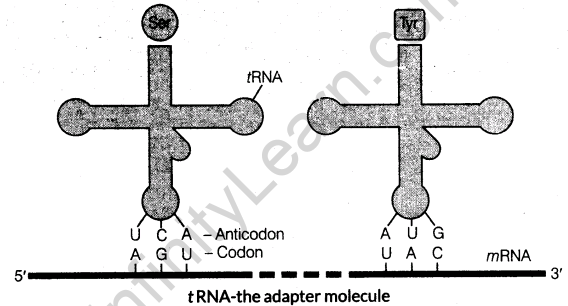
(iii)For initiation, there is specific JRNA (initiator iRNA). There are no tfRNAs for stop codons.
6. Translation is the process of polymerisation of amino acids to form a polypeptide.
(i)The order and sequence of amino acids are defined by the sequence of bases in the mRNA.
(ii)The amino acids are joined by a bond, which is known as a peptide bond. This process requires energy.
(iii)The different phases of translation are: .
(a)Activation of amino acids occur in presence of ATP and link to their cognate fRNA, i.e. charging of fRNA or aminoacylation of fRNA. If two such charged fRNAs are brought close, the formation of peptide bond between them would occur energetically in presence of a catalyst.
(b)Initiation of polypeptide synthesis occurs in ribosomes (cellular factory for protein synthesis).
- Ribosome consists of structural RNAs and about 80 different proteins.
- In its inactive state, it exists as two subunits, i.e. a large and a small subunit.
- When the small subunit encounters an mRNA, the process of translation of the mRNA to protein begins.
- There are two sites in the large subunit, i.e. the P-site and A-site for subsequent amino acids to bind to and thus, be close enough to each other for the formation of a peptide bond.
- The small subunit (with the fRNA) attaches to the large subunit in such a way that the initiation codon (AUG) comes to the P-site.
- An mRNA also has some additional sequences that are not translated, referred as untranslated regions (UTR). They are present at both 5′-end (before start codon) and at 3′ end (after stop codon) for efficient translation process
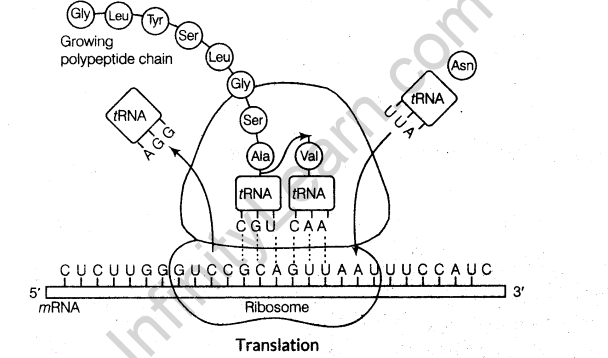
(c)Elongation of polypeptide chain occur when a second fRNA charged with an appropriate amino acid binds to the A-site of the ribosome
- A peptide bond (CO—NH) forms between the carboxyl group of methionine and the amino group of the second amino acid. The reaction is catalysed by the enzyme peptidyl transferase.
- The complexes composed of an amino acid linked to fRNA, sequentially bind to the appropriate codon in mRNA by forming complementary base pairs with the fRNA anticodon. ^ ‘ ’
- The ribosome movps ftShj cbdon to codon along the mRNA in . 5′-3′ direction. Amino acids are added one by one, translated into polypeptide sequences dictated by DNA and represented by mRNA.
(d) Termination of polypeptide synthesis occur when a release factor binds to the stop codon. As a result, the polypeptide synthesis or elongation stops releasing the complete polypeptide from the ribosome
7.Regulation of gene expression occurs at various levels. It results in the formation of a polypetide
(i)In prokaryotes, gene expression is regulated by the rate of initiation of transcription.
(ii) In eukaryotes, regulation is achieved at four levels
- Transcriptional level (formation of primary transcript).
- Processing levels (regulation of splicing).
- Transport of mRNA from nucleus to the cytoplasm.
- Translational level.
(iii) Genes in a ceil are expressed to perform a particular function or a set of functions.
(iv)The metabolic, physiological or environmental conditions regulate expression of genes.
(v)The development and differentiation of embryo into adult organisms are also a result of coordinated regulation of expression of several sets of genes.
(vi)In a transcriptional unit, the activity of RNA polymerase at a given promoter is in turn regulated by interaction with accessary proteins.
(vii)The accessibility of promoter regions of prokaryotic DNA in many cases is regulated by the interaction of proteins with sequences termed as operators,
(viii) The sequences of the operator bind a repressor protein. Each operon has its specific operator and specific repressor. For example, lac operon interacts with lac repressor only.
8.F Jacob and J Monod were the first to describe a transcriptionally regulated system.
(i)An operon is a unit of prokaryotic gene expression which includes sequentially regulated (structural) genes and control elements recognised by the regulatory gene product.
(ii)The various components of an operon are:
- Structural genes Fragments of DNA which transcribe mRNA for polypeptide synthesis.
- Promoter gene Sequence of DNA where RNA polymerase binds and initiates transcription.
- Operator Sequence of DMA adjacent to promoter where specific repressor protein binds.
- Regulator gene Codes for the repressor protein that binds to the operator and suppresses its activity, hence transcription does not occur. Also, represented as *i’ gene.
- Inducer Prevents the repressor from binding to the operator. Due to this, transcription is switched on. It may be a metabolite, hormone, etc.
9 .In lac operon. a polycistronic structural gene is regulated by a common promoter and regulatory genes.
(i)The lac operon consists of one regulatory gene (i gene) and three structural genes (z, yanda).
(a)i—for repressor of lac operon
z—for beta galactosidase (J3-gal) that catalyses the hydrolysis of lactose into galactose and glucose,
y—for permease, increases the permeability of the cell, a–for transacetylase.
(b)All the three gene products in lac operon are required for the metabolism of lactose.
(ii)Lactose is a substrate for enzyme beta-galactosidase and it regulates switching on and off of the operon, hence termed as inducer.
(iii) The lactose induces operon in the following ways
- Repressor of the operon is synthesised from the i gene.
- Repressor protein binds to the operator region of the operon and prevents RNA polymerase from transcribing the operon.
- In presence of an inducer, such as lactose or allolactose, the repressor is inactivated by interaction with the inducer. This allows RNA polymerase access to the promoter and transcription proceeds.
10.Human Genome Project (HGP) was launched in the year 1990. Its total approximate cost was 9 billion US dollars. It is a 13 year project coordinated by the US Department of,Energy and the National Institute of Health. The project was completed in 2003. It was closely associated with rapid development of a new area in biology called
11.The important goals of HGP are to:
(i)identify all the approximately 20,000-25,000 genes in human DNA.
(ii)determine the sequences of the 3 billion chemical base pairs that make up human DNA.
(iii)store this information in databases.
(iv)improve tools for data analysis.
(v)transfer related technologies to other sectors, such as industries.
(vi)address the Ethical, Legal and Social Issues (ELSI) that may arise from the project.
12.Methodologies of HGP is focussed on two main lines, i.e. expressed sequence tags and sequence annotation.
(i)Expressed Sequence Tags (ESTs) method is based on identifying all the genes that are expressed as RNA
(ii)Sequence annotation is the approach of simply sequencing the whole set of genome that contains all the coding and non-coding sequences and later assigning different regions in the sequence with functions.
- For sequencing, the total DNA from cell is isolated and converted in relatively smaller sizes as fragments.
- DNA fragments are cloned in suitable host using specialised vectors, such as Bacterial Artificial Chromosome (BAC) and Yeast Artificial Chromosome (YAC).
- Fragments of DNA are then sequenced by automated DNA sequences which work on principle developed by F Sanger.
- These sequences are arranged accordingly on the basis of overlapping regions on DNA fragments.
- The alignments of these sequences based on computer programmes were developed.
- At last, the genetic and physical maps of the genome were constructed by collecting information about certain repetitive DNA sequences and DNA polymorphism.
13.Salient features of human genome are as follows:
(i)The human genome contains 3164.7 million nucleotide bases.
(ii)The average gene consists of 3000 bases, but sizes vary greatly, with the largest known human gene being dystrophin at 2.4 million bases.
(iii)The total number of genes is estimated at 30,000 much lower than previous estimates of 80,000-1,40,000 genes. Almost all, (99.9%) nucleotide bases are exactly the same in all people.
(iv)The functions are unknown for over 50% of the discovered genes.
(v)Less than 2% of the genome codes for proteins.
(vi)Repeated sequences make up very large portion of the human genome.
(vii)Repetitive sequences are stretches of DNA sequences that are repeated many times, sometimes hundred to thousand times. They are thought to have no direct coding functions, but shed light on chromosome structure, dynamics and evolution.
(viii) Chromosome 1 has most genes (2968) and the Y has the fewest (231).
(ix) Scientists have identified about 1.4 million locations, where single base DNA differences, Single Nucleotide Polymorphism (SNPs) occur in humans.
14.Applications of HGP
- Knowledge from DNA sequences will define research leading to our knowledge of biological system.
- It will enable a radically new approach to biological research.
- It can be used to study genes in a genome.
- It can create new ways to diagnose, treat and prevent the disorders that affect humans.
15.DNA fingerprinting is a quick way to compare the DNA sequences of any two individuals.
(i)Alec Jeffreys developed the technique of DNA fingerprinting in an attempt to identify DNA marker for the inherited diseases.
(ii)DNA fingerprinting involves identifying differences in some specific regions in DNA sequence called as repetitive DNA (a small stretch of DNA is repeated many time).
(iii)The repetitive DNAs are separated from bulk genomic DNA as different peaks during density gradient centrifugation. The bulk DNA forms a major peak and the other small peaks are referred to as satellite DNA.
(iv)Satellite DNA can be classified as microsatellites, minisatellites, etc., depending on base composition, the length of segment and number of repetitive units.
(v)These sequences show high degree of polymorphism and form the basis of DNA fingerprinting.
(vi)Since DNA from every tissue (as blood, hair, etc) from an individual differs, they become very useful tool in forensic applications.
(vii)As the polymorphisms are inheritable, DNA fingerprinting is the basis of paternity testing.
(viii)Polymorphism (variation at genetic level) arises due to mutations. If an inheritable mutation is observed in a population of high frequency, it is called DNA polymorphism.
(ix)The mutations keep on accumulating generation after generation and form one of the basis of variability/polymorphism.
(x)There is a variety of different types of polymorphism ranging from single nucleotide change to very large scale changes.
16.Methodology of DNA fingerprinting This technique involves Southern blot hybridisation, using radiolabelled VNTR as a probe.
The methodology includes
- DNA is isolated and digested by the restriction endonucleases.
- DNA fragments are separated by electrophoresis.
- Separated DNA fragments are transferred to synthetic membranes like nitrocellulose or nylon.
- Hybridisation using labelled VNTR probe.
- Hybridised DNA fragments are detected by autoradiography.
The sensitivity has been increased by use of Polymerase Chain Reaction (PCR).
17.Variable Number of Tandem Repeats (VNTRs) belongs to a class of satellite DNA
called as minisatellite.
(i) The chromosome number repeats show very high degree of polymorphism. Due to this, the size of VNTR varies in size from 0.1-20 kb.
(ii)This DNA differs in individual to individual except in case of monozygotic (identical) twins.
(iii)Consequently, after hybridisation with VNTR probe, the autoradiogram gives many bands of different sizes. These bands give characteristic pattern of an individual DNA.
18.Applications of DNA fingerprinting
(i)It is useful as identification tool in forensic applications.
(ii)It is the basis of paternity testing in case of disputes.
(iii)It is used in determining population and genetic diversities and also in evolutionary biology.
Previous Year Examination Questions
1 Mark Questions
1.How is repetitive/satellite DNA separated from bulk genomic DNA for various genetic experiments. [Delhi 2014]
Ans.Satellite DNA is separated from bulk genomic DNA by density-gradient centrifugation technique
2.Mention the role of the codons AUG and UGA during protein synthesis. [Delhi 2011,2010]
Ans.AUG Acts as initiation codon and codes for amino acid methionine.
UGA Acts as stop/termination codon that signals termination of polypeptide synthesis.
3.Mention the contribution of genetic maps in human genome project. [Ml India 2011]
Ans.Genetic maps are used as a starting point in the sequencing of whole genomes.
4.Mention any two ways in which Single Nucleotide Polymorphisms (SNPs) identified in human genome, can bring out revolutionary changes in biological and medical sciences?[Ml India 2011 C]
Ans.(i)By tracing human history.
(ii) By finding chromosomal locations for disease associated sequences.
5.State which human chromosome has [Foreign 2011]
(i)the maximum number of genes and
(ii)the one which has the least number of genes
Ans.(i)Chromosome 1
(ii) Chromosome Y
6.Given below is a schematic representation of a lac operon in the absence of an inducer. Identify ‘A’ and ‘B’ in it. [Foreign 2008]
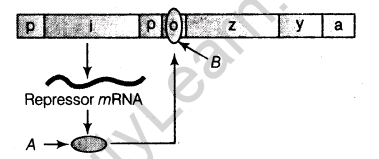
Ans.A- Repressor
B- Repressor bound to the operator region and prevent transcription of structural genes.
2 Marks Questions
7. How would lac operon operate in E.coli growing in a culture medium where lactose is present as source of sugar? [All India 2014C]
Ans.When lactose is present in a medium having E. coli, it will act as a substrate for enzyme beta-galactosidase and switches on the operon. Hence, it is also termed as an inducer.
8.Where does peptide bond formation occur in a bacterial ribosome and how? [Foreign 2014]
Ans.A peptide bond is formed between carboxyl group (—COOH) of amino acid at P-site and amino groun (—NH) of amino acid at A-site by the enzyme peptidyl transferase in a bacterial ribosome.
9.(i) Name the scientist who suggested that the genetic code should be made of a combination of three nucleotides.
(ii) Explain the basis on which he arrived at this conclusion.[Delhi 2014]
Ans.(i) George Gamow suggested that the genetic code should be made of a combination of three nucleotides.
(ii) This is because the code must be of three bases in order to code for 20 amino acids since there, are only four bases (i.e. 43 or 4 x4 x4=64) which code for 20 amino acids.
10.Explain aminoacylation of tRNA.[All India 2014 C]
Ans.Aminoacylation of the tRNA It is also, called as charging of tRNA. It is the first phase of translation where amino acids are activated in the presence of ATP and linked to their cognate tRNA.
Enzyme and AMP are released. tRNA complexed with amino acid is sometimes called charged fRNA. The amino acid is linked to 3’—OH end of tRNA through its —COOH group.
AA— AMP + t + tRNA-> AA—tRNA+ AMP+ E (aminoacyl adenylate enzyme
11.Why is charging of fRNA necessary during translation process?[All India 2014 C; Delhi 2008]
Ans.Process of Charging of fRNA
Amino acids are activated in the presence of ATP and linked to their cognate tRNA. This is called charging of tRNA (amino acylation).
The process is required as the formation of peptide bond between the amino acids is favoured energetically, when they are brought together. Activation of amino acids by ATP provides the energy for the formation of peptide bond.
12.One of the salient features of the genetic code is that it is nearly universal from bacteria to humans. Mention two exceptions to this rule, Why are some codes said to be degenerated? [Foreign 2014]
Ans.Genetic code is nearly universal except in mitochondrial codons and in some protozoans. Some amino acids are coded by more than one codon, hence somes codes are said to be degenerated
13.Draw a schematic diagram of lac operon in its switched off position. Label the following,
(i)Structural genes
(ii)Repressor bound to its correct positions
(iii)Promoter gene
(iv)Regulatory gene [Foreign 2012]
Ans.
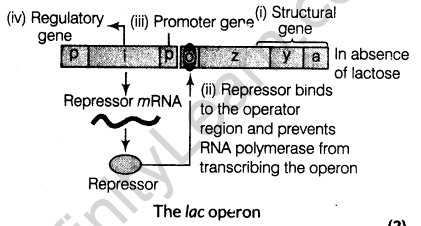
14.Write the full form of VNTR. How is VNTR different from Probe?[All India 2011]
Ans.VNTR—Variable Number Tandem Repeat. Difference between VNTR and Probe
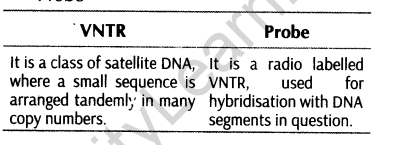
15.Mention the role of ribosome in peptide bond formation. How does ATP facilitate it? [All India 2010]
Ans.(i)Ribosomes are main cellular site of protein synthesis. They also act as catalyst (23S rRNA) in prokaryotes for formation of peptide bonds.
(ii) ATP provides energy for activation of amino acids.
16.How is the translation of mRNA terminated? Explain. [Delhi 2009]
Ans.Termination of translation of mRNA :
When one of the termination codons (UAA, UAG, UGA), comes at the A-site, it does not code for any amino acid and there is no tRNA molecule for it. It leads to termination of polypeptide synthesis.
The synthesised polypeptide is released from the ribosome and is catalysed by a ‘release factor
17.Study the figure given and answer the questions
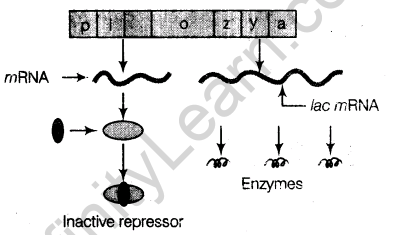
(i)How does the repressor molecule get inactivated?
(ii)When does the transcription of lac mRNA stop?
(iii)Name the enzyme transcribed by the gene z [Delhi 2009]
Ans.(i)When the inducer binds to the repressor, the repressor is inactivated.
(ii) The transcription stops when lactose becomes exhausted or when there is no need for energy to the cells.
(iii) beeta-galactosidase
18.Explain the dual function of AUG codon. Give the sequence of bases if is transcribed from and its anticodon [All India 2009]
Ans.Dual function of AUG codons are:
(i) Codes for methionine (amino acid).
(ii) Functions as initiation codon.
It is transcribed by TAC on DNA. Anticodon-UAC
19.(i)Name the molecule X synthesised by i gene. How does this molecule get inactivated
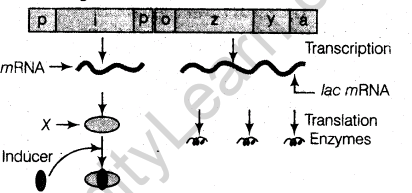
(ii)Which one of the structural genes codes for beeta galactosidase?
(iii)When will the transcription of this gene stop? [All India 2009]
Ans.(i)Molecule X—Repressor protein. When an inducer combines with it, it is inactivated.
(ii) z gene
(iii) Transcription stops when
- Substrate lactose is not available.
- Energy source, glucose is available to the cells.
20.Name the category of codons UGA belongs to. Mention another codon of the same category. Explain their role in protein synthesis. [Foreign 2009]
Ans.It is a stop/termination codon. UAA or UAG are the other codons of same catego
Thesv codon terminate the translation proceso, they stop the elongation of polypeptide chain during translation,
21.(i)Name the molecule M that binds with the operator
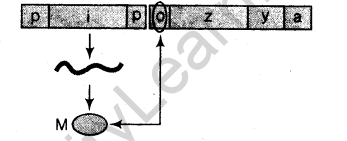
(ii)Mention the consequences of such binding.
(iii)What will prevent the binding of the molecule M with the operator gene? Mention the event that follows. [Foreign 2009]
Ans.(i)M-Repressor
(ii) When repressor binds to the operator, transcription by RNA-polymerase is prevented.
(iii)An inducer prevents the binding of repressor to operator. The event that follow is RNA polymerase gets access to the promoter and transcription proceeds.
22.(i) Differentiate between unambiguous and degenerate codons.
(ii) Write two functions of the codon AUG. [All India 2010 C]
Ans.(i)Differences between unambiguous and degenerate codons are
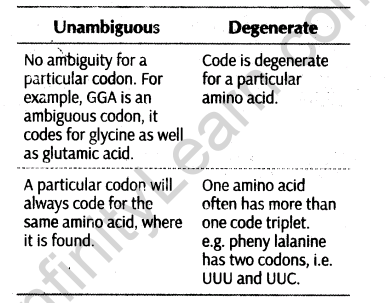
(ii)Functions of Codon AUG
Codes for methionine and is the starting point of protein synthesis (initiation codon).
23.Genetic code is specific and nearly universal. Justify. [All India 2008 C]
Ans.In genetics, one codon codes for only one amino acid, hence it is unambiguous and specific. Since the codon codes for the same amino acid in any organism. It is universal.
For example, from bacteria to human UUU would code for phenylalanine (Phe). Some exceptions are found in mitochondrial codon and in some protozoans
3 Marks Questions
24.(i) Which human chromosome has
- maximum number of genes and
- which one has fewest genes?
(ii) Write the scientific importance of single nucleotide polymorphism identified in human genome. [All India 2014c]
Ans.(i) (a)Chromosome 1 has most genes,i.e. 2968.
(b) Y-chromosome has the fewest genes, i.e. 231. (1K)
(ii) Scientists have identified about 1.4 million locations, where single base DNA differences, Single Nucleotide Polymorphism (SNPs) occur in humans.
Since, these sequences have high degree of polymorphism they form the basis of DNA fingerprinting.
25.(i) Name the scientist who postulated the presence of an adapter molecule that can assist in protein synthesis.
(ii) Describe its structure with the help of a diagram. Mention its role in protein synthesis.[Foreign 2014]
Ans.(i)Francis Crick proposed the presence of an adapter molecule which could read the code on one end and on the other end would bind to the specific amino acids.
(ii) A clover leaf structure of tRNA
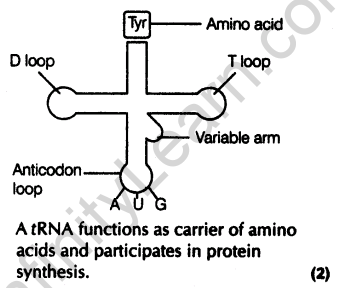
26.Following a severe accident, many charred-disfigured bodies are recovered from the site making the identification of the dead very difficult. Name and explain the technique that would help the authorities to establish the identity of the dead to be able to handover the dead to their respective relatives. [All India 2014 C]
Ans.To find out the identity of the dead person to handover him to his respective relatives we perform DNA fingerprinting of both, i.e. the dead person and their relatives. This is done because DNA fingerprinting uses short nucleotide repeats called Variable Number of Tandem Repeats (VNTRs) as markers. VNTRs vary from person to person and are inherited from one generation to the next. And only closely related individuals have similar VNTRs.
27.In a maternity clinic, for some reasons the authorities are not able to hand over the two newborns to their respective real parents. Name and describe the technique that you would suggest to sort out the matter. [HOTS; All India 2013]
Ans.DNA fingerprinting can sort out this dispute of maternity
The steps of this technique are:
Step I The technique involves Southern blot hybridisation using radiolabelled VNTR as a probe.
Step II The methodology includes
(i)DNA is isolated and digested by the restriction endonucleases.
(ii)DNA fragments are separated by electrophoresis.
(iii) Separated DNA fragments are transferred to synthetic membranes like nitrocellulase or nylon.
(iv) Hybridisation using labelled VNTR probe.
(v)Hybridised DNA fragments are detected by autoradiography.
28.(i) Explain DNA polymorphism as the basis of genetic mapping of human genome.
(ii) State the role of VNTR in DNA fingerprinting. [All India 2013]
Ans.(i)Human genome project was launched in 1990. Methodologies of HGP is focused on two main lines, i.e. expressed sequence tags and sequence annonation. The genetic and physical maps of the genome were constructed by collecting information about certain repetitive DNA sequences and DNA polymorphism.
(ii) Variable Number of Tandem Repeats (VNTRs) belong to a class of satellite DNA called as minisatellite. VNTRs are used as probes in DNA fingerprinting.
29.Given below are the sequence of nucleoside in a particular mRNA and amino acids coded by it UUUAUGUU CGAGUUAGUGUAA Phe – Met – Phe – Glu – Leu – Val
Write the properties of genetic codes that can be and that cannot be correlated from the above given data. [Delhi 2013C, 2010C, 2009C]
Ans.UUUAUGUUCGAGUUAGUGUAA Phe – Met – Phe – Glu – Leu – Val According to the sequence given above
(i) Codon is triplet.
(ii) Genetic code is specific and unambiguous
For example, AUG – Codes for methionine (Met)
GAG – Codes for glutamine (Glu)
UUA – Codes for leucine (Leu)
(iii) Codon is degenerate, i.e. same amino acids are coded by more than one code.
For example, UUU and UUC both codes for phenylalanine (Phe).
(iv) Code is read without punctuation.
(v)UUA acts as a terminating code.
Thus, all properties of codon are satisfied from the above given data. Except the one that mostly AUG work as a initiating codon.
30.How are the structural genes activated in lac operon in coli?[All India 2012]
Ans.Lacoperon consists of
(i)an operator, which control all structural genes as a unit,
(ii)a regulatory gene (i gene)
(iii)three structural genes (z, y, a) which code for enzymes and
(iv)a promoter, where RNA polymerase binds for transcription.
The regulatory gene codes for a repressor protein and repressor has high affinity for the operator region and prevents RNA polymerase from transcribing the structural genes i.e. the lac operon is switched off or inactive
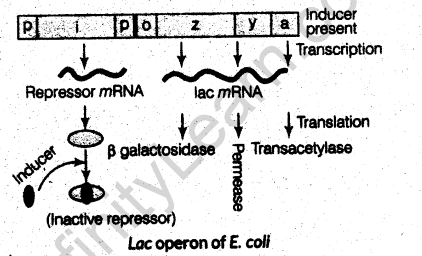
lac operon in presence of inducer when inducer (lactose) is added it binds with repressor protein and inactivates it. This allow RNA polymerase access to promoter and transcription proceeds
31.State the conditions when genetic code is said to be
(i)Degenerate
(ii)Unambiguous and specific
(iii) Universal [Foreign 2012]
or
Unambiguous, universal and degenerate are some of the terms used for the genetic code. Explain the salient features of each of them.[All India 2011]
Ans.(i)Genetic code is degenerate because some amino acids are coded by more than one codons.
(ii) Genetic code is unambiguous as one codon codes for only a particular amino acid.
(iii) Genetic code is universal as a codon codes for the same particular amino acid in all organisms from human to bacteria.
32.(i) Name the scientist who called tRNA an adapter molecule.
(ii)Draw a clover leaf structure of fRNA showing the following :
(a)Tyrosine attached to its amino acid site.
(b)Anticodon for this amino acid in its correct site (codon for tyrosine is UAC).
(iii)What does the actual structure of tRNA look like? [All India 2011]
Ans.(i)Francis Crick
(ii) (a)Francis Crick proposed the presence of an adapter molecule which could read the code on one end and on the other end would bind to the specific amino acids.
(b) A clover leaf structure of tRNA

(iii) tRNA looks like inverted L.
33.Given below is a scheme representation of a lac operon
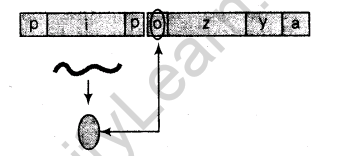
(i)Identify i and p.
(ii) Name the inducer for this operon and explain its role. [Foreign 2011]
Ans.(i)i-Regulatory gene, p—Promoter gene.
(ii)Inducer is lactose. Its function? are : It enters the cell and binds to the repressor and inactivates it. As a result, repressor cannot bind to the operator. This allows RNA polymerase to have access to the promoter and transcription proceeds
34.The following is the flow chart highlighting the steps in DNA fingerprinting technique. Identify A, B, C, D, E and F.
Ans.A -Restriction endonuclease
B-Ethidium bromide
C-Agarose
D-VNTR E-A piece
F-Autoradiography
35.Explain the role of regulatory gene in a lac operon Why is regulation of lac operon called negative regulation? [All India 2010 c]
Ans.The lac operon consists of one regulatory gene and three structural gene (z, y and a)The i gene codes for the repressor of the lac
If repressor protein binds to operator region of operon, it prevents RNA polymerase from transcribing the operon. Whereas, in presence of lactose (inducer) the repressor become inactivated due to interaction with inducer.
This allow RNA polymerase access to promoter and transcription proceeds. Regulation of lac operon is negative, it can be visualised as regulation of enzymes synthesis by its substrate. Regulation of lac operon by repressor is referred to as negative regulation
36.A considerable amount of lactose is added to the growth medium of coli. How is the lac operon switched on in the bacteria? Mention the state of the operon when lactose is digested.[All India 2010 C]
Ans.In lac operon, when lactose is added, it enters the cell wall with the help of permease, a small amount of which is already present in cell. Lactose binds itself to active repressor and changes its structure. The repressor now fails to bind to the operator.
Then, RNA polymerase starts transcription of operon by binding to promoter site-P. All the three enzymes for lactose metabolism are synthesised. After sometime, when whole of lactose is consumed, there is no inducer present to bind to the repressor. Then the repressor becomes active again, attaches itself to the operator and finally switches off the operon.
37.(i) How many codons code for amino acids and how many do not?
(ii) Explain the following giving one example of each
- Unambiguous and specific codon
- Degeneration codon
- Universal codon
- Initiator codon [All India 2010c]
Ans.(i)Out of 64 codons 61 codons codes for amino acids and rest 3 codons do not code for any amino acids. These function as stop codons.
(ii) (a) Unambiguous and specific—codon codes for only one amino acid, so it is unambiguous and specific, e.g. GGA.
(b) Some amino acids are coded by more than one codon so, the code is degenerate, e.g. UUV
(c)Codon is nearly universal. Some exceptions to ^ ,the rule are mitochondrial codon ahd in some protozoans, e.g.,UUV
(d)Initiator codon. AUG has dual function. It codes for methionine and also acts as initiator.
38.(i) Why is fRNA called an adapter? (ii) Draw and label a secondary structure of fRNA. How does the actual structure of fRNA look like? [All India 2010 C; 2008]
Ans.(i)tRNA binds to a specific amino acid and it also reads the codon of the amino acid bound to it through it anticodon. So, it is called an adapter molecule.
(ii) In actual structure, thetRNA is a compact molecule and looks like inverted L

39.(i) Identity the polarity from a to d,in the diagram below and mention how many more amino acids are expected to be added to this polypeptide chain.
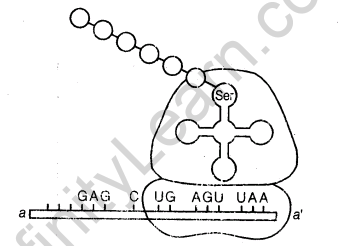
(ii)Mention the DNA sequence coding for serine and the anticodon of fRNA for the some amino acid.
(iii)Why are some untranslated sequence of bases seen in mRNA coding for a polypeptide? Where exactly are they present on mRNA?[Foreign 2009]
Ans.(i)a to a! is 5′———– > 3′ . No more amino acid will be added.
(ii) TCA, Anticodon is UCA.
(iii) The untranslated regions are required for efficient translation process. They are present before the initiation codon at the 5 – end and after the stop/termination codon, at the 3 – end.
40.One of the codons on mRNA is AUG. Draw the structure of fRNA adapter molecule for this codon. Explain the uniqueness of this fRNA. [Delhi 2008]
Ans.
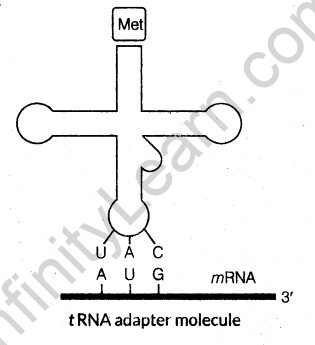
Uniqueness of this tRNA is that, it is referred to as initiator tRNA because it is specific for initiation.
41.Study the mRNA segment given below which is complete to be translated into a polypeptide chain.

(i)Write the codons A and
(ii)What do they code for?
(iii)How is peptide bond formed between two amino acids in the ribosome? [All India 2008]
Ans.(i)A- -AUG, B— UAA/UAG/UGA
(ii) AUG codes for methionine. UAA/UAG/ UGA does not code for any amino acid but, brings about termination of polypeptide synthesis.
(iii) In the large subunit of ribosome, there are two sites where subsequent amino acids bind to and come close enough for the formation of peptide bond. It is catalysed by the peptidyl transferase.The ribosome also acts as a catalyst for peptide bond formation.
42.(i)State the arrangement of different genes that in bacteria is referred to as operon.
(ii)Draw a schematic labelled illustration of lac operon in a switched on state.
(iii)Describe the role of lactose in the lac operon. [All India 2008; Delhi 2008C]
Ans.(i)The different genes in an operon are:
- Structural genes
- Operator gene
- Promoter gene
- Inhibitor/regulatory gene.
An operator gene lies adjacent to the structural gene.
Promoter gene lies on its other side.
On the other side of promoter gene, lies regulatory/inhibitory gene
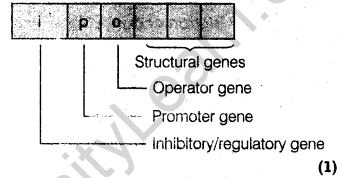
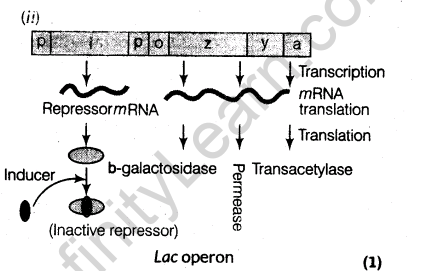
(iii)Role of lactose in lac operon
- It is the substrate for the enzyme (3-galactosidase.
- It functions as the inducer and regulates the switching on and off of the operon.
- When lactose is present, it combines with the repressor protein, which otherwise has high affinity for the operator.
- It inactivates the repressor from binding to the operator and hence, transcription continues, i.e. the operon is switched on
43.Describe how the lac operon operates, both in the presence and the absence of an inducer in coli.
[All India 2014]
Ans.Lac operon is made up of one regulatory gene and three structural genes (z, y, a).
Its function in the presence and the absence of inducer is as under:
(i) When inducer (lactose) is absent i-gene regulates and produces repressor mRNA in the absence of lactose, which translate repressor. The repressor protein binds to the operator region of operon and as a result prevents RNA polymerase to bind to the operon. The operon is switched off in this situation. (ii) When inducer (lactose) is the present Lactose acts as an inducer and binds to the repressor. Thus, forming an inactive repressor.
The repressor fails to bind the operator region. The RNA polymerase binds to the operator and transcripts lac mRNA Lac mRNA is known to be polycistronic which produces all three enzymes,
i.e. p-galactosidase, permease and trans acetylase. Operon is switched on in this situation.
44.Explain the process of translation. [All India 2014 C]
Ans.Translation is the process of polymerisation of amino acids to form a polypeptide.
The different phases of translation are:
(i) Activation of amino acids
(ii) Initiation of polypeptide synthesis
(iii) Elongation of polypeptide chain
(iv) Termination of polypeptide
45.(i) What is a genetic code?
(ii) Explain the following Degenerate code, Unambiguous code. Universal code, Initiator code.
[All India 2014C]
Ans.The relationship between the sequence of nucleotides on mRNA and sequence of amino acids in the polypeptide is called genetic code,
(i)Out of 64 codons 61 codons codes for amino acids and rest 3 codons do not code for any amino acids. These function as stop codons.
(ii) (a) Unambiguous and specific—codon codes for only one amino acid, so it is unambiguous and specific, e.g. GGA.
(b) Some amino acids are coded by more than one codon so, the code is degenerate, e.g. UUV
(c)Codon is nearly universal. Some exceptions to ^ ,the rule are mitochondrial codon ahd in some protozoans, e.g.,UUV
(d)Initiator codon. AUG has dual function. It codes for methionine and also acts as initiator.
5 Marks Questions
46.(i)Write the specific features of the genetic code AUG.
(ii) Genetic codes can be universal and degenerate. Write about them, giving one example of each.
(iii) Explain aminoacylation of the tRNA. [All India 2013]
Ans.(i)Genetic code AUG is an initiation codon that works as a start signal and also codes for methionine.
(ii) (a) Genetic codes are universal, i.e. a codon specifies the same amino acid from a virus, to a tree or human being.
(b) The degeneracy of genetic code can be proved by the fact that there are 64 triplet codons, and only 20 amino acids, the incorporation of some amino acids must be influenced by more than one codon with the exception of tryptophan (UGG) and methionine (AUG) that are specified by single codons, while all other amino acids are specified by two to six codons
(iii)Aminoacylation of the fRNA Refer to answer 10
47.Given below is the schematic representation of lac operon of E. coli. Explain the functioning of this operon when lactose is provided in the growth medium of the bacteria. [Delhi 2013 c]
![]()
Ans. Lactose in the lac operon regulates the switching the operon, on and off. If lactose is present in the medium, it acts as an inducer here and the substrate for the enzyme ^-galactosidase.
It binds to the repressor and forms an inactive repressor which fails to bind to the operator region of the Operon.
The RNA polymerase thus, binds to the operator and transcribes lac mRNA. lac mRNA produces all three enzymes (|J-galactosidase, permease and transacetylase) known as polycistronic. Therefore, Operon will be switched on in the presence of the lactose.
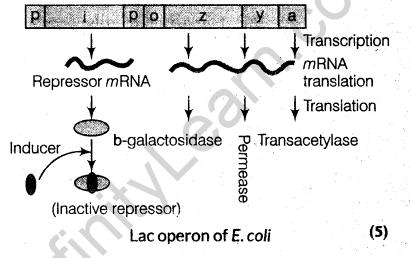
48.Study the schematic representation of the genes involved in the lac operon given below and answer the questions that follow
![]()
(i)Identify and name the regulatory gene in this operon. Explain its role in ‘switching off’ the operon.
(ii)Why is lacoperon’s regulation referred to as negative regulation?
(iii)Name the inducer molecule and the products of the genes z and y of the operon. Write the function of these gene products. [Foreign 2010]
Ans.(i)i gene-regulatory gene. It codes for the repressor protein of the operon,, which is synthesised constitutively.The repressor has the affinity for the operator gene. It binds to the operator and prevents the RNA polymerase from transcribing the structural genes. (2)
(ii) When repressor binds to the operator, the operon is switched off and transcription is stopped. So, it is called negative regulation.
(iii) Lactose is an inducer molecule.Gene ‘z’ codes for |3-galactosidase which is responsible for the hydrolysis of lactose into galactose and glucose.
‘y’ gene codes for permease. It increases the permeability of the cell to lactose.
49.DNA polymorphism is the basis of DNA fingerprinting technique. Explain.
(ii) Mention the causes of DNA polymorphism. [Foreign 2010]
Ans.(i)DNA polymorphism It Is the occurrence of inheritable mutations at a frequency greater than 0.01 in a population.
(a)Such variations often occur in non-coding sequences. They keep on accumulating generation after generation.
(b)Types of polymorphism range from single nucleotide change to very large scale changes.
(c)Single nucleotide polymorphism is used to diagnose disease related sequences of DNA on the chromosome.
(d)Variable number of tandem repeats show a high degree of polymorphism.
(ii) DNA polymorphism occurs due to mutations
50.Name and describe the technique that will help in solving a case of paternity dispute over the custody of a child by two different families.[All India 2010]
or
Two blood samples A and B picked up from the crime scene were handed over to the forensic department for genetic fingerprinting. Describe how the technique of genetic
fingerprinting is carried out. How it will be confirmed whether the samples belonged to the same individual or to two different inividuals? [Delhi 2009]
or
Explain the steps of DNA fingerprinting that will help in processing of the two blood samples ‘A’ and ‘B’ picked up from the crime scene. [Foreign 2009]
Ans.The technique which help in solving a case of paternity dispute over the custody of child by two families is called DNA fingerprinting.
Procedure of DNA fingerprinting.
(i) VNTR form the basis of DNA fingerprinting: The repeats of it show high degree of polymorphism.
(ii) After hybridisation with the radiolabelled VNTR probe and autoradiography, bands of various sizes are formed.
(iii) Bands form a characteristic pattern, which varies from person to person.
(iv) The patterns developed by sample A and B, can confirm that whether they belong to one person or two different persons.
Miscellaneous Questions
3 Marks Questions
1.(i) Name the enzyme responsible for transcription of tRNA and the amino acid, the
initiator tRNA gets linked with.
(ii) Explain the role of initiator tRNA in initiation of protein synthesis. [Delhi 2012]
Ans.(i) RNA polymerase transcribes tRNA and the amino acid, the initiator tRNA gets linked with methionine.
(ii) The initiator tRNA binds to the amino acids methionine, at its amino acid acceptor site.
It has anticodon loop, which has anticodon for methionine, i.e. UAC, it recognises the start codon (AUG) at P site and binds to it according to complementarity of bases.
2.Given below is a part of the template strand of a structural gene.
TACCATTAGGAT
(i)Write its transcribed mRNA strand with its polarity.
(ii)Explain the mechanism involved in initiation of transcription of this strand.[Delhi 2008]
Ans.(i)5′-AUGGUAAUCCUA-3′.
(ii) Initiation of transcriptionTranscription is carried out by the enzyme DNA-dependent RNA polymerase, that catalyses the polymerisation of nucleotides in the 5′->3′ direction only.Strand of DNA with 3′-» 5′ polarity acts as the template.RNA polymerase binds to the promoter site, a particular sequence of DNA and starts the process.
3.Describe the role of RNA polymerases in transcription in bacteria and in eukaryotes. [Foreign 2010]
Ans.In bacteria, there is a single DNA-dependent RNA polymerase which catalyses the formation of mRNA, tRNA and rRNA.
In eukaryotes, there are three types of RNA polymerases, which show division of labour.
In the nucleus, there are three types of RNA polymerases
(i) RNA polymerase I transcribes rRNAs, (28S, 18S and 5.8S)
(ii) RNA polymerase II transcribes the precursor of mRNA called hnRNA.
(iii)RNA polymerase III transcribes tRNA, 5 SrRNA and SnRNAs.
4.(i) Name the enzyme responsible for the transcription of tRNA and the amino acid, the
tRNA gets linked with.
(ii) Explain the role of initiator tRNA in intiation of protein synthesis. [Delhi 2012]
Ans.(i)RNA polymerase III is responsible for transcription of tRNA and methionine is the amino acid that gets linked with the initiator tRNA.
(ii) Initiator tRNA carries amino acid methionine at its amino acid binding site and has anticodon UCA at its anticodon binding site. Initiator tRNA binds with the codon AUG present on the mRNA and in this way the initiator tRNA plays a role in initiation of protein synthesis.
5 Marks Questions
5.Where do transcription and translation occur in bacteria and eukaryotes respectively? Explain the complexities in transcription and translation in eukaryotes that are not seen in bacteria. [Foreign 2010]
Ans.In bacteria, both processes occur in cytoplasm as there is no nucleus.
In eukaryotes, transcription occurs in nucleus, while translation occurs in the cytoplasm.
Complexities in eukaryotic transcription
Complexities in translation in eukaryotes are
- The mRNA formed in nucleus has to be transported to the cytoplasm.
- Transcription and translation cannot be coupled in eukaryotes.









